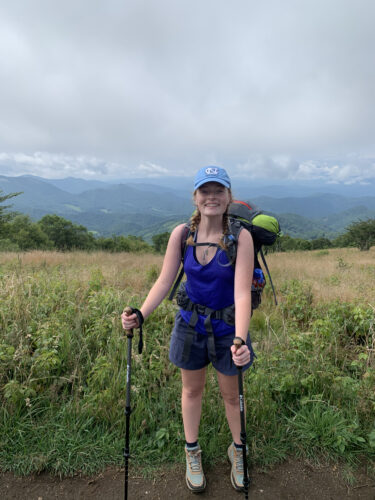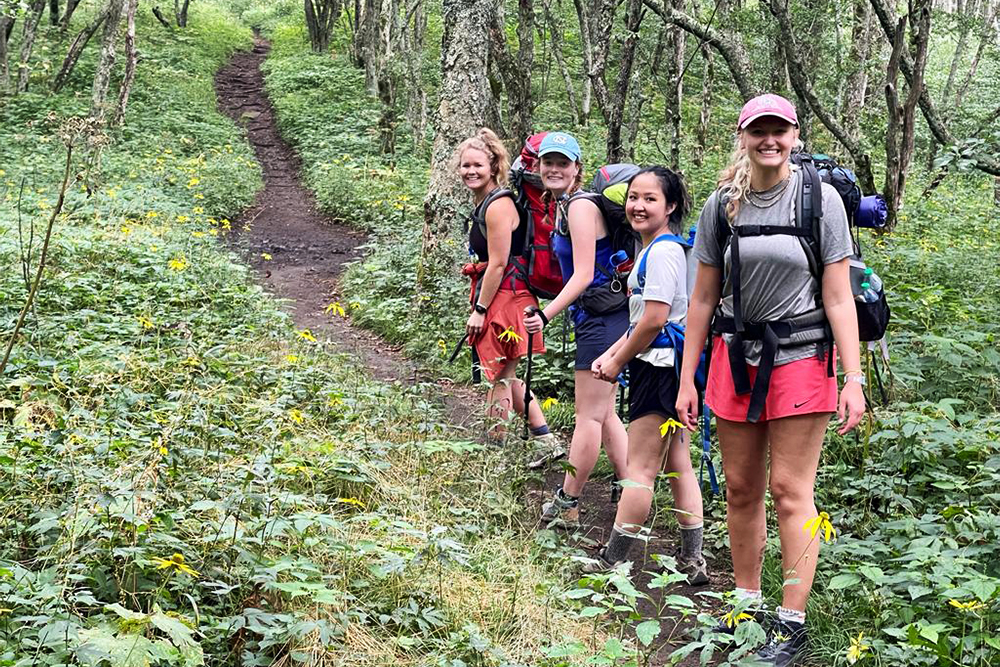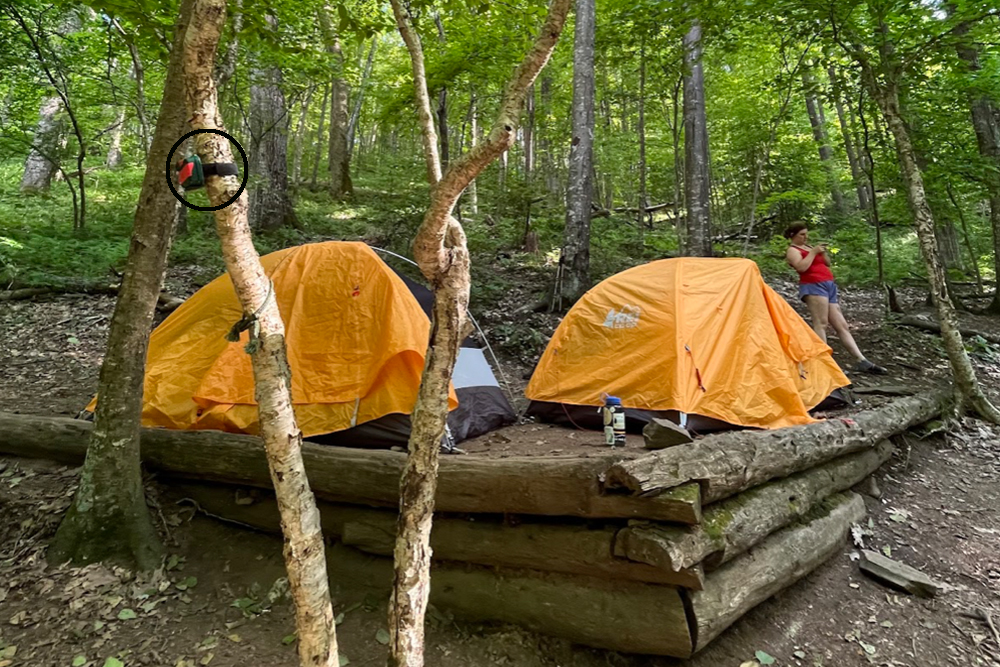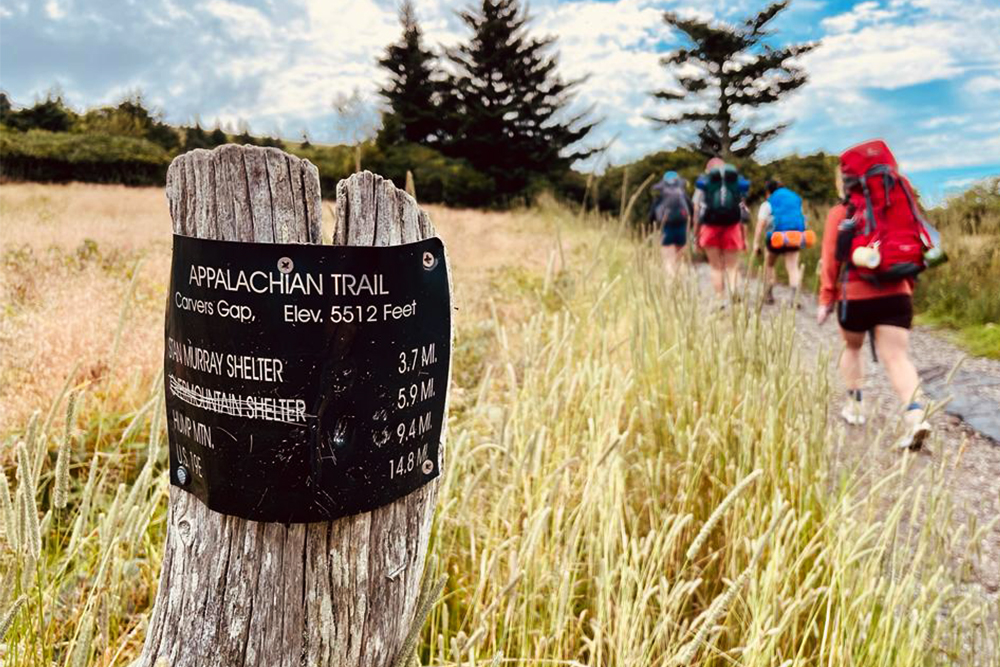“What am I even doing?”
I kept asking myself this question during my ascent of Yellow Mountain. As my 50-pound pack shifted on my back and my sweat continued to glue my t-shirt to my skin, I focused on the deep breaths of my friends and wondered if they were thinking the same thing.
But when I summited, that all changed. The sky opened and an Appalachian Mountain valley spread out before me — and I forgot the struggle that got me there. I wanted more views like that one. I wanted to hike all over the Roan Highlands.

Grace Kinder is a rising senior at UNC-Chapel Hill and a summer research assistant at the UNC Highlands Field Site in Western North Carolina. She is organizing and leading the BatPack project. (photo by Noa Meiri)
That was the summer of 2022. At the time, it was only the second backpacking trip I had ever been on. I was a rising junior studying environmental science at UNC-Chapel Hill and had recently completed a semester at the Highlands Field Site, where I learned how to conduct a research project from start to finish.
That hike was the first of what would eventually become the BatPack project. The team included UNC-Chapel Hill biologist Rada Petric, Carolina alumni Vy Pham and Noa Meiri, and Sadie Rose Jones, a friend and citizen scientist helping collect data. The goal: to monitor bat populations.
Since then, BatPack has transformed into a citizen science study that recruits local hikers and leverages their passion for the outdoors by engaging them in a long-term bat monitoring project along southern portions of the Appalachian Trail (AT).
Those hikers will join my team on two- and three-day hikes between May and August 2023. Our goal is to collect data on the absence or presence of bats along the trail and teach the public how they can contribute to bat conservation efforts.
While the AT is home to a wide variety of bat populations, little to no research has been conducted to quantify the number or species found along the trail itself. This is the first study of its kind to do so.
With help from volunteers, hikers, and local outdoor companies, we are strapping audio monitors to small trees or tents to observe these populations. The data we collect on the changes that occur within these bat communities will help us establish a baseline for population metrics. In the future, this information will be essential for studying behavior and social structure and identifying threatened or endangered species. It will also aid our understanding of how human activity along the trail affects these animals.

Sadie Rose Jones, Grace Kinder, Vy Pham, and Noa Meiri on their first-ever BatPack hike in the summer of 2022. (photo by Rada Petric)
A typical weekend of monitoring bats consists of driving to the trailhead, gearing up, and heading out on the trail with specific campsites in mind. Volunteers and I spend the day hiking, chatting, and enjoying the beauty and serenity of the natural world around us as we slowly approach our campsite for the night.
We scout out the best locations to set up our AudioMoth recorders for bats. These ultrasonic detectors are programmed ahead of time to record bat calls from sunset to sunrise. In densely wooded areas, we look for skinny trees to strap them to (see below), turn them on, and then leave them recording until morning. In areas with no trees or other structures, we attach them to our tents for the night. It’s that simple.

Once the team sets up camp, they strap acoustic monitors to nearby trees. Note the one circled here. (photo by Reagan Jarrett)
After each hike, we download the audio files from the recorders and upload them to a special software system called Kaleidoscope, which deciphers the species associated with the sounds we’ve collected.
Unfortunately, it is not guaranteed we will record any bats at our campsites. But during past trips, we’ve been lucky to record hundreds of ultrasonic noises. Further study of these sounds will help us distinguish the bat species present.
For me, BatPack is more than recording different populations. It’s also about bringing enthusiastic people together from diverse backgrounds who would have never met otherwise. In the process, all volunteers learn about the various bat species in the area, why we should conserve them, and the scientific process that conservation involves.

BatPack hikers cross a meadow on the Appalachian Trail. (photo by Grace Kinder)
I’m just beginning my education of bats on a species and biological level. Throughout this project, I have expanded my knowledge of these wonderful mammals and the key part they play in our ecosystems and economy. Bats provide essential help to humans on multiple levels. Not only do they eat pesky insects, but they also help disperse seeds — so many that they save the agricultural industry $3.7 billion per year, according to a 2011 study.
Working on this project not only allows me to raise awareness for bat conservation and to study these fascinating creatures, but also spend my time in beautiful rural locations of the Appalachian Mountains.
In the future, I hope this project can expand into the northern sections of the AT and potentially other backpacking trails, too.
People often ask me: “Doesn’t it get exhausting carrying all that weight, sleeping in the woods, and smelling like a skunk day after day?” Absolutely not. When I’m backpacking, I don’t usually remember how difficult the climb was or how horrible I smelled in my tent that night. I remember the breathtaking views and amazing friends I bonded with along the way.
I’d pick this type of work over a desk job any day.


